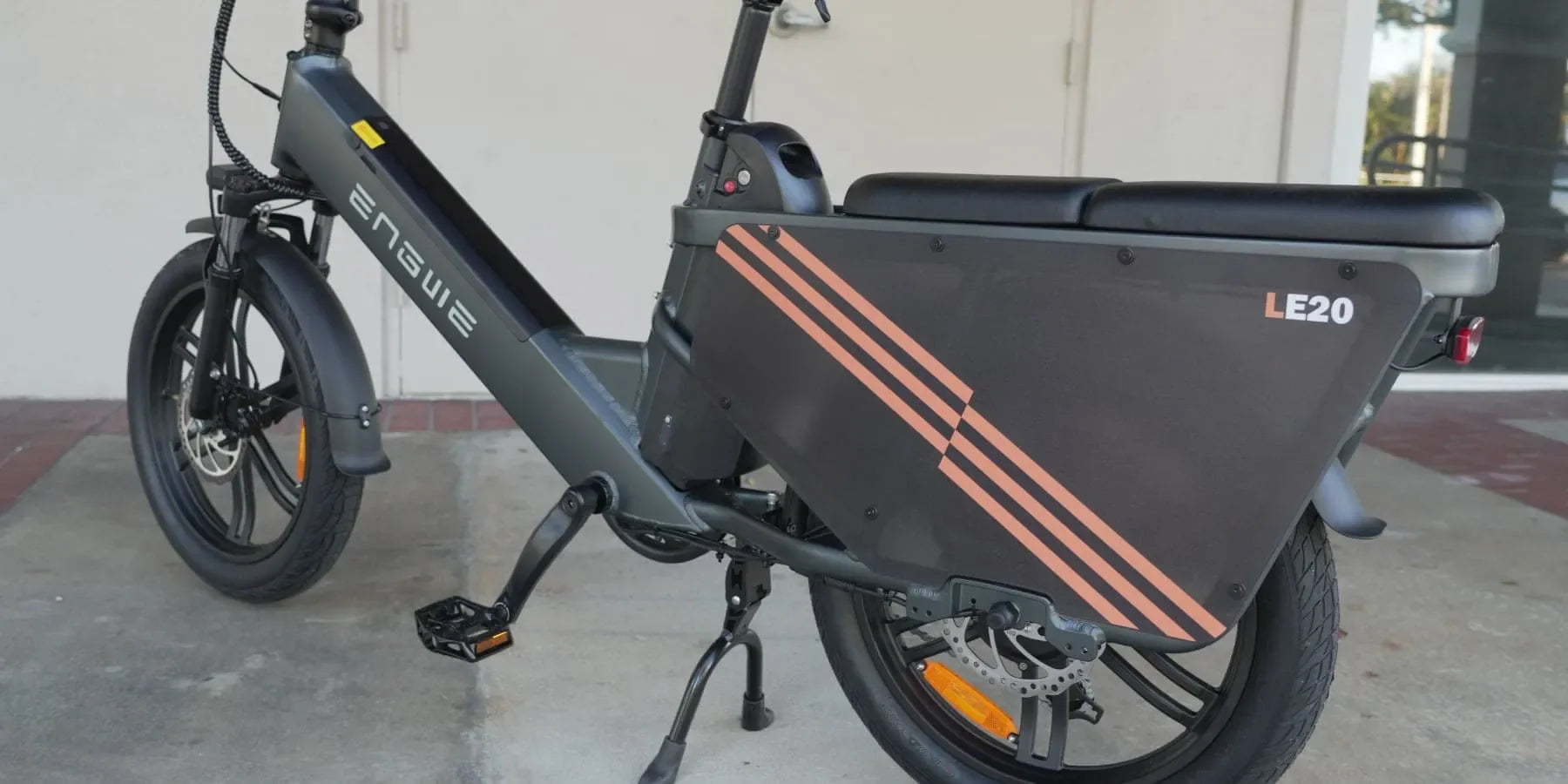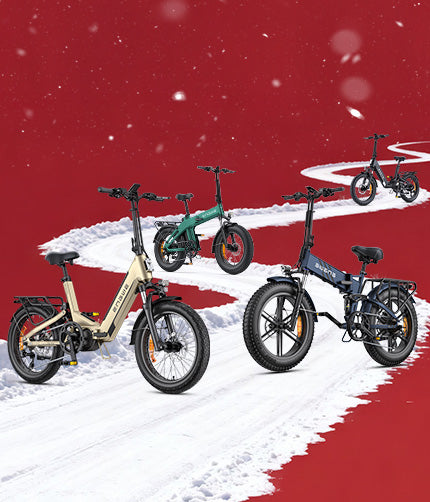The right electric bike frame sets the foundation for an incredible riding experience. The step-over vs. step-through debate goes beyond the looks; it’s about aligning the bike’s core structure with your body, lifestyle, and desired use. This guide covers the most important differences along five critical dimensions. It will support you in looking past the aesthetics to make an educated decision that guarantees years of comfort, performance, and functionality.
1. Accessibility, Comfort, and Rider Profile
Arguably, the main distinction between these two frame styles is how you get on and off the bike – which directly impacts comfort and rider-focusedness. This dimension is the least performance-related, and more about ergonomics and ease of use. And it’s also the first one to consider – understanding which frame fits you better, physically, will pave the way for riding more often and more comfortably.
Step-Through E-Bikes:
This genre of e-bikes has a low or nonexistent top tube. That’s the distinction. This construction allows the rider to “step through” the bike, rather than lifting a leg high up over the back of the bike to mount or dismount. This can be a game-changer for people who have joint issues that make it difficult to get their legs high, a lack of balance, or just regular stiffness. It lowers the chance of stumbling when dismounting. In city traffic, especially where you have to continuously stop at lights and start back up again, putting a foot down quickly and securely can really make a huge difference. No cycling outfit should hinder your mobility; bike shorts, jeans, and even long dresses are all compatible, and this is something only a step-through bike can guarantee. However, remember to look for a frame with a stabilizing down tube.
Step-Over E-Bikes:
The bicycle frame with the classic triangle form, also known as the diamond frame, is a common design. This diamond frame encourages a more forceful and front-leaning riding stance. Newer cyclists may not be as fast with mounting. It is critical to be able to straddle the bike with both of your feet on the ground. For many people, this requires a significant leg lift. Nevertheless, stand-over height is a decisive measurement; ensure you have one or two additional inches of clearance between your body and the top tube when standing over it.
2. Performance, Handling, and Structural Integrity
The frame’s geometry is the backbone of the electric bike – it determines its strength, weight distribution, and how it responds to your input. While modern engineering has closed the gap, a step-through frame is inherently different structurally from a step-over design. To help you discern which frame design is better, let’s cover their riding characteristics. They notably differ as soon as you push the bike to its performance limits, either with speed, the amount of weight on board, or the difficulty of the terrain. The step-over frame is often taken for granted in terms of its structural integrity. A step-through frame design possesses some features worth mentioning.

3. Utility, Cargo Capacity, and Real-World Use Cases
An e-bike is more than a motorbike; it is a means of transportation, for running errands or even an adventure machine. How you utilize your e-bike, whether commuting with a laptop, shopping, or even riding with a kid, largely determines the optimal frame. Each frame design is ideal for particular situations.
Step-through for Daily Utility:
- Child Seat Champion: For any rider who would love to mount a rear-mounted baby carrier, this is arguably the safest and most convenient option. You can mount the bike without lifting your leg high in proximity to the bike seat and your kid, hence the process is much smoother and less precarious.
- Effortless Cargo Loading: Whenever your bike is loaded with groceries in a rear basket or panniers, you will appreciate a step-through frame. The step-through frame enables easy loading and balancing to get on and off without unbalancing a top-heavy bike at every attempt.
- Delivery and Courier Work: For any rider who has to mount and dismount multiple times each day because their work involves riding for hours, the energy and time saved per ride adds up significantly.
Step-Over for Specialized Hauling:
- Bikepacking and Touring: The e-bike frame is much stronger when it comes to handling heavy, distributed loads, especially for long-distance touring with rear and handlebar bags, front panniers, etc. This frame allows for a more competitive stance, which is essential for multi-day rides.
- Frame Bag Compatibility: The triangle of a step-over frame is open and empty, hence it’s very compatible with a frame bag. It helps you carry your batteries, tools, and other dense items.
- Towing Trailers: A stiffer frame proves to be a more convenient and stable connection point when a trailer is mounted or towed. The rear of the frame is stiff and stable, hence making it easier.
4. Top Recommendations and Other Considerations
With a step-through, it’s usually not a question of trading down on power or features. The ENGWE L20 3.0 Pro is an unabashed example of taking high-performance engineering all the way to the most accessible form factor. In other words, it’s the crème de la crème of compact step-through e-biking, perfect for everyone who’s uncompromising in their urban riding. The e-bike is designed with meticulous attention to detail to give you the best power, comfort, and security that engineering can offer:
The Premier Step-Through Choice: ENGWE L20 3.0 Pro

Engineered for Pure Comfort First – The ENGWE L20 3.0 Pro is the ultimate embodiment of compact e-bikes, complete with a full-suspension design boasting a front hydraulic fork and 30mm of rear travel that can soak up 90% of road bumps.
An Innovative Motor Design – Engineered with a 250W Mivice mid-drive motor, the ENGWE L20 3.0 Pro boasts a peak torque of 100Nm. Coupled with a torque sensor, this design provides all the energy needed to make climbing hills in towns feel like cruising.
Reach and Charge Capabilities – Inspiring confidence, a huge 720Wh Samsung battery offers up to a 160KM range. Furthermore, charging with an 8A charger is remarkably fast.
Smart Security and Safety – The ENGWE includes ENGWE IoT support with GPS that can locate your e-bike in case of theft, send a video or picture via 4G, and push an alert message to the app.
Expanded Choice – A Gen III step-through folding frame makes the e-bike accessible, complete with 20” X 3.0” puncture-resistant tires and a cargo rack.

The list of your main needs can also be used as a checklist to choose between frame types. Below is a summary of the most common arguments for step-over and step-through variations:
| Feature / Use Case | Step-Through E-Bike | Step-Over E-Bike |
|---|---|---|
| Frequent City Stops | Ideal due to easy mounting/dismounting. | Less convenient for constant stops. |
| Riders with Limited Mobility | Highly recommended for accessibility. | Challenging due to high top tube. |
| Carrying a Child in a Rear Seat | Safest and most convenient option. | More difficult and less safe to mount. |
| Aggressive Riding / Off-Road | Less suitable due to frame flex. | Superior due to a stiffer, stronger frame. |
| Long-Distance Touring / Bikepacking | Possible, but less ideal for heavy loads. | Recommended for structural integrity and load capacity. |
| Maximum Speed and Performance | Can be high-performance, but the frame is not optimized for it. | Generally stiffer and better handling at high speeds. |
Maintenance and Upkeep:
- Mechanical Similarity: Both frame styles use the same core electrical and mechanical components, so routine maintenance schedules for brakes, chain, and motor are the same.
- Accessibility: A user tip is that for cleaning and servicing, some mechanics find a step-through’s open design can give slightly easier access to the bottom bracket and chain area, but it’s only a marginal convenience.
- Cable Routing: While most modern e-bikes feature cleaner internal cable routing, a stiffer step-over frame may provide slightly better protection for cables routed through the top tube, but may be more complex for the home mechanic to service.
Resale Value and Future-Proofing:
- Broader Appeal & High Demand: In the city and urban commuting markets, step-through e-bikes have a massive audience. Riders in older age brackets and more casual riders prefer them. It is easier to sell and preserve value over time due to high demand.
- Enthusiast Market: High-performance step-over e-bikes, especially e-MTBs, are always in high demand among enthusiasts and hold their value well if maintained.
- The Biggest Factor: Aside from crash damage and usage, none of this matters as much as the overall health and capacity of the battery. It can cost several thousand dollars to replace a battery if there is a problem.

5. Frequently Asked Questions
Q1: Is a step-through e-bike less durable than a step-over?
A1: Not necessarily. Most high-quality step-through frames are reinforced to be very strong and durable for their intended use, such as leisure and commuting. A step-over frame is inherently more rigid, making it better suited for more extreme and demanding rides.
Q2: Does frame type affect battery placement and bike balance?
A: Yes. The battery is often cleanly integrated into the downtube of a step-over frame, which is ideal for weight balance. Step-through frames often place the battery along the seat tube or on a rear rack. A centralized, integrated battery will generally offer superior handling.
Q3: Can I find a high-performance e-bike with a step-through frame?
A: Undoubtedly. In the past, step-through frames were common on lower-spec leisure bikes, but that’s no longer the case. Now, most brands offer mighty mid-drive motors, high-range batteries, and high-end equipment like full suspension on an accessible open frame.
In the end, the best frame is the one that fits your body, your lifestyle, and your riding ambitions perfectly.









